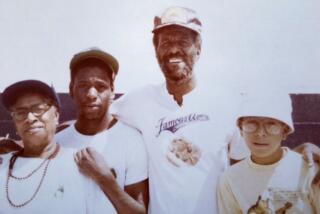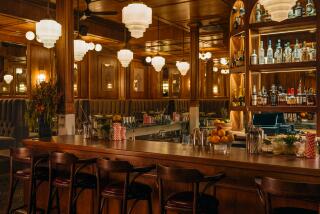When Bob’s Was the Big Hangout
- Share via
A fast-food cultural icon that was born as a lark and became an empire was created by the guy voted in high school “Least Likely to Succeed.”
But succeed he did.
For the record:
12:00 a.m. Nov. 9, 2003 For The Record
Los Angeles Times Tuesday November 04, 2003 Home Edition Main News Part A Page 2 National Desk 1 inches; 61 words Type of Material: Correction
Bob’s Big Boy -- The “L.A. Then and Now” column in Sunday’s California section incorrectly stated that the Glendale Bob’s Big Boy restaurant and corporate headquarters were razed for the Glendale Galleria. They were both farther east, across the street from each other. Bob’s Big Boy was at 900 E. Colorado Blvd. and the corporate office at 1001 E. Colorado Blvd.
For The Record
Los Angeles Times Sunday November 09, 2003 Home Edition Main News Part A Page 2 National Desk 1 inches; 63 words Type of Material: Correction
Bob’s Big Boy -- The “L.A. Then and Now” column in the Nov. 2 California section incorrectly stated that the Glendale Bob’s Big Boy restaurant and corporate headquarters were razed for the Glendale Galleria. They were both farther east, across the street from each other. Bob’s Big Boy was at 900 E. Colorado Blvd. and the corporate office at 1001 E. Colorado Blvd.
Nearly seven decades ago, a few years before the McDonald brothers, Dick and Mac, opened their hamburger joint in San Bernardino, Bob Wian created American culture on a bun when he introduced the fast-food phenomenon with the “double-deck” cheeseburger and added already popular drive-in carhop service to deliver it.
From his flagship restaurant in Glendale in 1936, the “double-deck” hamburger dubbed the Bob’s Big Boy became an instant success.
Within two decades, Wian expanded his business into a chain across the nation. Each outpost included a larger-than-life statue of a chubby mascot wearing red and white overalls and holding his burger high like an edible beacon. Bob’s was more than a mere restaurant. In the age of rock ‘n’ roll and hotrods, it was a teenage play land, the hottest place to be after a high school football game.
It was a date-night and cruiser destination, a place to flirt, where boys eyeballed one another’s engines, got into fistfights over girls and arranged drag races. Teenagers gorged on French fries dipped in blue cheese dressing and “suicide Cokes” splashed with cherry, vanilla, lemon and chocolate flavorings. Inside, teens table-hopped among their friends, flipping coins into mini-jukeboxes that blared hit songs.
The chain’s popularity as a family spot to eat began to grow when Wian cast his chubby Big Boy character in a comic book handed out to children at the tables, another industry first.
A native Philadelphian, Wian moved to Glendale in 1928, at age 14, with his parents and two younger sisters. His father, Robert, imported hand-carved wooden furniture and built a three-story Mediterranean-style house in the hills on Royal Boulevard, a home recently designated a Glendale historical landmark.
But when his father lost all his money in the 1929 stock market crash, the younger Wian went to work as a short-order cook to help family finances. He graduated from Glendale High in 1932 and married his high school sweetheart, Frances Abbott. They moved into a small apartment above the old Bard Theater.
In 1936, he sold his 3-year-old DeSoto Roadster convertible for $350, using the money to open a tin-roofed, 10-stool hamburger joint on Colorado Boulevard in Glendale, between a nursery and a liquor store.
The following year, a small group of musicians with Chuck Foster’s Big Band patronized the place and kiddingly asked Wian to dream up “something different for a change.”
“Why not?” Wian mused. He carved a sesame-seed bun into three horizontal slices, placed two hamburger patties between them, and finished off the concoction with lettuce, cheese and his special pickle relish.
“Wow!” they chorused. “This is it!”
And so it was.
In 1938, Wian changed the name from Bob’s Pantry to Bob’s Big Boy and converted the stand into a drive-in restaurant, offering a double-deck hamburger, French fries and shakes “so thick you can eat them with a spoon,” all for 60 cents.
Wian said the double-decker really began as a joke.
“The whole idea just took off,” Wian said in a 1989 interview. “And in those days people were skeptical of hamburger meat, so we ground it ourselves in front of the customers.”
Even more famous than the double-deck burger, however, was the plump Big Boy image used as a trademark to welcome diners. Wian modeled it after a 6-year-old he knew named Richard.
According to company legend, the boy cleaned counters in exchange for Wian’s double-decker burgers. Richard spent hours on a stool at the counter, eating his way through several burgers. Sometimes his mother or his brother, Glenn, had to drag him home.
One day, Ben Washam, a regular customer and a Looney Tunes animator, sketched the little boy on a napkin.
Over the years the Big Boy character evolved. The first rendering, the one on the napkin, showed him barefoot, holding a hamburger with a bite out of it, his cheeks full of food. Most of the fiberglass statues still around today show him with his thumbs tucked into the suspenders that hold up his red-and-white overalls.
Word of the unusually built burger and its pudgy mascot spread quickly and inspired numerous nationwide imitators, none of which lasted very long. Big Boy begat Chubby Boy, Hi-Boy, Bun Boy, Beefy Boy, Country Boy, Brawny Boy, Fat Boy, Husky Boy, Yumi Boy, Lucky Boy, Super Boy and hundreds of other variations.
By 1940, after a good-looking young carhop made the cover of Life magazine, the work was seen as a glamour job. Wian was inundated with applicants. Westways magazine described carhops as “belles of the boulevards.”
Within about a decade, Wian was elected to the Glendale City Council. A month later, in October 1948, he was sworn in as the youngest mayor, at age 34. He quit the following year for more time “to take an occasional fishing trip,” he said.
The Wians eventually divorced. In the 1970s, their only child, Robert Paul, died of brain cancer.
In 1957, Wian married June Baehler, a widow with two children, Chapman and Barbara. The couple adopted two more children, Casey and Julie.
Wian was regarded as a giant in the restaurant industry. As a student at Glendale High, “he was the class cut-up, really and truly, but always very industrious,” said his sister, Dotty Weis, who was his executive secretary for many years.
“He was a gem; everyone loved him,” she said. “His motto was always ‘Keep ‘em laughing.’ ”
In the 1950s, Wian’s restaurants grew in popularity and were franchised throughout Southern California. Some became so busy that Wian had to hire security guards to handle the traffic: Cars would line up for blocks to get into the parking lots.
Soon, Bob’s Big Boy became a battleground, a place where police and other merchants warred with teenage cruisers.
But Wian praised his young customers in a speech at a restaurant convention at the Biltmore Hotel in 1955. “In many cases, today’s teenagers are better behaved than some adults. We probably serve 10,000 teenagers every weekend and I can say we rarely have incidents,” he said. “Teenagers are more tolerant, more appreciative of little things done for them. I can contradict a lot of scuttlebutt about juvenile delinquency.”
Despite his faith in the younger generation, the Big Boy statues became targets of fraternity and teenage pranks. They were stolen almost as fast as they were erected, leaving police radios to crackle with reports that an abducted statue wearing a black pompadour and checkered overalls had been seen joy-riding on Colorado Boulevard in the back of a cherry-red roadster.
Another time, teachers and students at a Southern California high school arrived one morning to find lunch tables stacked to form a pyramid, crowned by the familiar plastic lad from the local Bob’s Big Boy.
Franchise owners began filling the statue with sand and anchoring it to its base to make future thefts more difficult.
After opening 22 Big Boy restaurants and franchising hundreds of others across the country, Wian sold the business to Marriott in 1967 for $7 million. Big Boy’s presence began to fade as Marriott and later other owners converted many of the Bob’s restaurants into more modern eateries.
The original Glendale Bob’s and corporate headquarters eventually were razed for the Glendale Galleria. The mini-museum that was near the restaurant’s front counter -- Bob’s first spatula, menu and other memorabilia -- now belong to Wian’s son Casey Wian, a CNN reporter.
In 1968, three decades after the birth of the double-deck Big Boy, McDonald’s began to market the Big Mac. By then, Wian’s fame and fortune were secure. He had blazed a trail in employee relations too, becoming among the first restaurant owners to give employees profit-sharing and health insurance.
In the 1970s, Wian moved his family to an 800-acre ranch in Valyermo, near Palmdale. A decade later, he moved to Newport Beach, where he died in 1992, at age 77.
That same year, Bob’s Big Boy on Riverside Drive in Toluca Lake, the third Bob’s built and the oldest still in existence, was declared a California State Point of Historical Interest. It is considered an excellent transitional example of the 1940s Moderne architectural style, leaning toward the 1950s “coffee shop modern” that is endemic in Los Angeles. It still offers carhop service on Saturdays and Sundays from 5 to 10 p.m.
More to Read
Eat your way across L.A.
Get our weekly Tasting Notes newsletter for reviews, news and more.
You may occasionally receive promotional content from the Los Angeles Times.








